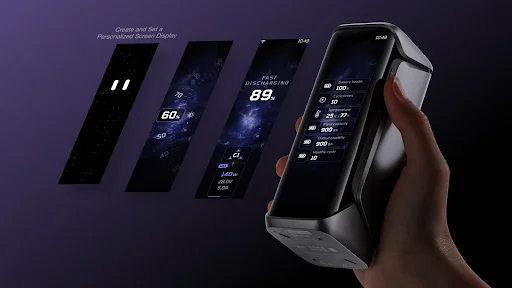We live in a world where everything runs on power—from our phones to laptops to cameras—and waiting hours for them to recharge can feel like forever.
That’s where fast charging power banks come in. But are they really worth the upgrade compared to standard ones? Let’s break down how fast charging works, what makes it different, and whether the extra cost actually pays off in real life.
Dive deeper into the topic with these carefully selected related articles just for you!
What’s the Real Difference Between Fast and Standard Power Banks?
At their core, both types of power banks serve the same purpose: they store electrical energy and deliver it to your devices when you’re away from a wall outlet. The key difference lies in how quickly they can deliver that power.
A standard power bank might output around 5 V / 2 A (10 W), which is enough for basic phones or small gadgets. A fast charging power bank, on the other hand, supports higher voltage and current—often 9 V / 2 A (18 W), 20 V / 3 A (60 W), or even 100 W or more for laptops.
In short, fast charging is like upgrading from a garden hose to a fire hydrant: same water, much higher pressure.
How Fast Charging Actually Works
Fast charging isn’t magic—it’s science and smart electronics. Modern fast chargers use intelligent communication between your device and the power bank to decide the highest safe charging rate.
Here’s what happens in a simplified way:
- The power bank identifies your device’s charging protocol (USB-PD, Quick Charge, PPS, etc.).
- It adjusts voltage and current automatically to deliver the maximum safe speed.
- As your battery nears full, the charger slows down to prevent overheating or overcharging.
That’s why plugging into a high-wattage power bank doesn’t damage your device—it only delivers as much as the device can safely handle.
Common Fast Charging Standards You’ll See
Different devices use different fast-charging technologies. Here are a few of the most common you’ll encounter:
| Standard | Typical Output | Common Devices | Notes |
| USB Power Delivery (USB-PD) | 18 W – 100 W+ | iPhones, iPads, MacBooks, most laptops | Most universal and future-proof |
| Qualcomm Quick Charge (QC 3.0 / 4.0) | 18 W – 27 W | Android phones | Popular in older and mid-range Androids |
| PPS (Programmable Power Supply) | Variable (up to 45 W) | Samsung Galaxy, Pixel | Adjusts voltage dynamically for efficiency |
| SuperCharge / Warp Charge / Dash Charge | 30 W – 65 W+ | Select Android phones | Brand-specific systems |
When buying a fast charging power bank, make sure it supports your device’s charging protocol—otherwise you’ll only get standard speeds.
Charging Speed: The Numbers That Matter
Let’s look at real-world performance.
- A standard 10 W power bank takes about 3 hours to fully charge a modern smartphone.
- An 18 W fast charger can do the same in around 1.5 hours.
- A 60 W USB-PD power bank can charge some laptops from 0 % to 80 % in under 2 hours.
That’s literally cutting your waiting time in half—or more. For travelers, remote workers, or anyone constantly on the move, that difference can be huge.
Capacity vs. Speed: A Delicate Balance
One misconception is that a fast-charging power bank always holds more energy. In reality, capacity (measured in mAh or Wh) and speed (measured in watts) are independent.
- Capacity = how much total energy it stores.
- Output power = how quickly it can deliver that energy.
Think of it as a gas tank vs. the size of the fuel pump. You could have a massive 20,000 mAh power bank that charges slowly—or a smaller 10,000 mAh unit that charges devices twice as fast.
When choosing, look for a balance: enough capacity to recharge your devices multiple times, and a high enough wattage output to do it quickly.
When Fast Charging Really Makes a Difference
1. During Travel
If you’re hopping between airports or commuting long hours, every minute counts. A fast charging power bank can recharge your phone in half the time while you wait for your flight or grab lunch.
2. For Remote Work or Photography
Laptops, drones, and cameras often support USB-C fast charging. With a high-output power bank (45 W – 100 W), you can top off your gear between shoots or meetings without finding a wall plug.
3. For Emergency Use
Power outages don’t care about your schedule. A fast charger can quickly bring your essentials—phone, flashlight, medical device—back to life when time is critical.
4. For Power-Hungry Devices
Tablets and gaming consoles like the Nintendo Switch require more than 10 W to charge efficiently. Without fast charging, they may take forever—or not charge while in use at all.
The Pros of Fast Charging Power Banks
✅ Time Savings — The biggest benefit. Charging your phone in one hour instead of three is a real convenience.
✅ Multi-Device Flexibility — Many fast-charging power banks have multiple ports (USB-C PD + USB-A QC) to handle phones, tablets, and laptops simultaneously.
✅ Future-Proofing — As new devices demand higher wattages, investing in a capable power bank today means it’ll still work with next-gen gadgets.
✅ Better Energy Management — Intelligent controllers prevent overheating and voltage drops, improving safety and battery longevity.
The Cons (and When You Might Not Need It)
⚠️ Higher Cost
Fast charging units use advanced circuits and higher-grade components, which can make them 20–40% more expensive than standard models.
⚠️ Heavier & Bulkier
With more power comes more hardware. Some 100 W PD power banks weigh twice as much as basic 10 W models.
⚠️ Compatibility Limits
If your device doesn’t support fast charging, it won’t benefit from a faster power bank—you’ll still charge at regular speed.
⚠️ Battery Life Considerations
Although rare, frequent high-speed charging can cause slightly faster wear on some batteries. Most users won’t notice, but if you only trickle-charge overnight, standard speed is gentler.
Real-World Scenarios: Fast vs. Standard
| Situation | Standard Power Bank | Fast Charging Power Bank |
| Commuting (1 hr) | ~30% phone charge | ~70–80% phone charge |
| Charging a Laptop (60 Wh) | Not supported | Fully charges in 1.5–2 hrs |
| Weekend Camping Trip | Enough for 2 phone charges | 3+ phone charges + tablet top-off |
| Emergency Call Boost (10 min) | Adds ~10–15% | Adds ~30–40% |
For users who rely heavily on their devices, those differences translate into real-world convenience and peace of mind.
Safety Features to Look For
Whether fast or standard, safety matters most. Quality power banks include built-in protections against:
- Overcurrent and short-circuit damage
- Overheating and voltage spikes
- Overcharging your devices
- Automatic power cutoff when full
Fast-charging models often go a step further with temperature monitoring and smart voltage negotiation (via USB-PD or PPS), ensuring stable and efficient operation across a wide range of devices.
How to Know If Your Device Supports Fast Charging
Check your device’s specs or charger label. Look for any of the following terms:
- “PD 3.0 / PD 2.0”
- “Quick Charge 3.0 / 4.0”
- “Fast Charge 18 W / 30 W / 45 W”
- “Super Fast Charge”
If your phone or laptop supports any of these, a fast-charging power bank will maximize performance.
If not, don’t worry—fast chargers are backward-compatible and will safely revert to standard speeds.
The Cost Question: Is the Upgrade Worth It?
So, is upgrading to a fast charging power bank really worth the price?
If you only charge your phone overnight at home, probably not. A standard power bank will do the job perfectly fine.
But if you travel, work remotely, or use multiple high-demand devices daily, the upgrade pays for itself in time saved and convenience gained. For many, that’s worth every penny.
Consider it like upgrading to a faster internet plan—you don’t need it every second, but once you experience the difference, it’s hard to go back.
A Quick Buying Checklist
When shopping for your next power bank, check these features:
- ✅ USB-C Power Delivery (PD 3.0 or higher)
- ✅ At least 18 W output for phones, 45 W+ for laptops
- ✅ Multi-port design (USB-C + USB-A)
- ✅ Clear display or LED indicators
- ✅ Certified safety protection and airline-approved capacity (under 100 Wh)
These details ensure you get fast, safe, and reliable performance whether at home or on the road.
Conclusion
Fast charging power banks aren’t just a gimmick—they represent the next step in how we stay connected in a fast-paced world. While standard chargers still serve basic needs, the time savings, versatility, and performance of fast charging models make them a clear winner for most modern users.
If you rely on your devices daily—or hate waiting around—upgrading to a fast-charging power bank isn’t just worth it; it’s the smart move.
Check out this standout post that’s capturing attention and sparking great conversations.






